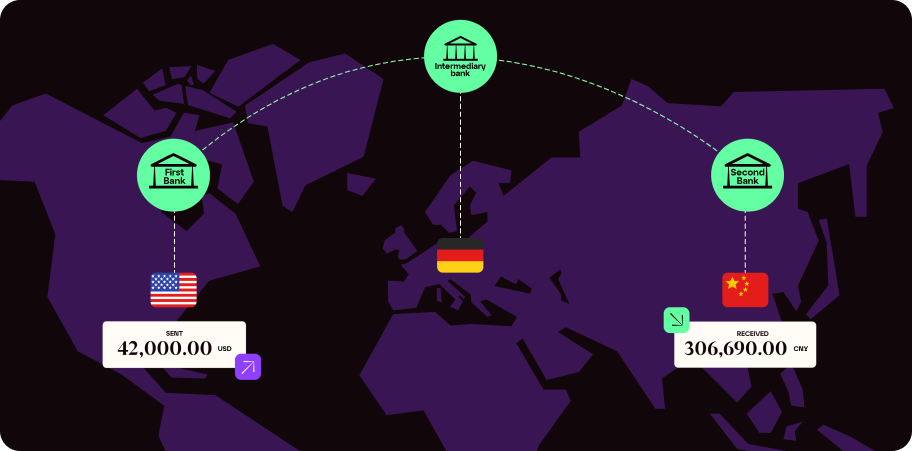Publication date
Share this article
Have you ever wondered why your international money transfers take longer than expected? The answer may lie in the role of intermediary banks.
When sending money overseas, it is very often not a direct transfer from one bank to another. Instead, the funds pass through one or more intermediary banks before reaching the recipient's account. These intermediary banks play a crucial role in facilitating cross-border transactions, but their involvement can also lead to delays and additional fees.
Understanding the role of intermediary banks is essential for any company that regularly sends or receives money internationally. In this article, we'll delve into what intermediary banks are, how they operate, and the impact they have on the speed and cost of international transfers.
What is an intermediary bank?
An intermediary bank is a financial institution that acts as a middleman between two banks that don't have a direct relationship with each other during cross-border transactions. These specialised banks bridge the gap when sending and receiving institutions from different countries need to transfer money but lack established financial connections.
Their purpose? To keep money flowing across borders, even when banks aren't directly connected.
Think of it like trying to send a package to someone in another country when your local delivery service doesn't operate there. You need another company that works with both your local service and the destination service to get your package where it needs to go.
When is an intermediary bank required?
An intermediary bank is required when your bank and the receiving bank do not have a direct relationship with each other. Think of it like needing a mutual friend to introduce you to someone new. Without that connection, the transaction simply can't happen.
For example, your bank in the Netherlands may not be able to send money directly to a bank in Hong Kong if they don’t have accounts set up that can facilitate the transfer. In that case, a third-party intermediary bank that has relationships with both banks will step in to keep your money moving.
Several factors can add additional complexity:
- Currency conversion needs: If your bank doesn't handle your beneficiary's currency directly, the intermediary might also manage the currency exchange — but this is a service they provide, not the main reason they're required to facilitate the transfer.
- Geographic distance: Banks in distant countries are less likely to have direct relationships, making intermediaries more necessary for, say, transactions between Uruguay and Malaysia than between France and Germany.
- Banking regulations: Different countries have different banking rules, so intermediaries often help navigate these regulatory differences.
How do intermediary banks work?
Intermediary banks operate primarily through the SWIFT network — a massive messaging system that connects over 11,000 financial institutions worldwide. This network is the backbone of international transactions, allowing banks to securely communicate and process transactions across borders.
The process follows a simple chain:
- Your bank (the originator bank) sends payment instructions through the SWIFT network
- The intermediary bank receives these instructions
- The intermediary processes the transaction between the two banks involved
- The funds arrive at the recipient's bank

In this scenario, both the sending and receiving banks have a relationship with the intermediary bank. If they don't? That's when more intermediary banks join the chain to complete the transaction.
Here's an example of how this might work:
- Joe runs a business in the UK and banks with First Bank.
- He needs to pay his supplier, ABC Company, in the United States, which uses Second Bank.
- First Bank (UK) doesn't have a direct relationship with Second Bank (US). So what happens?
- First Bank uses an intermediary bank — Middle Bank — that has accounts with both First Bank and Inter Bank.
- This second intermediary — Inter Bank — has a relationship with Second Bank, so the transaction is made possible by these two intermediaries having relationships with each other, creating a bridge between First Bank and Second Bank.
The thing is, Joe doesn't even need to deal with the intermediary banks at all. First Bank handles all the routing details through the SWIFT network, sending payment instructions to the intermediaries so the money finds its way to Second Bank.
The tradeoff? When intermediary banks are involved in your cross-border transaction, your payment generally takes a bit longer to reach its destination.
What’s the difference between intermediary banks and correspondent banks?
You might hear both terms thrown around in the banking world. In some regions (such as the EU), people use these terms fairly interchangeably. But in many other parts of the world, there are subtle but important differences.
What is a correspondent bank?
A correspondent bank is a financial institution that provides regular, ongoing services to another bank in a different country. Think of it as your bank's permanent representative in a foreign market.
These banks don't just help with one-off transactions — they're long-term partners that handle a whole range of financial services for other banks.
Correspondent banks vs intermediary banks
In countries that make a clear distinction between the two, intermediary banks operate in a more limited capacity, primarily focused on facilitating international financial transactions. Correspondent banks, on the other hand, provide a broader range of services, such as:
- Processing international wire transfers
- Managing business accounts
- Gathering and exchanging documents
- Accepting deposits
- Managing investments
- Conducting business transactions on the other bank's behalf
So while intermediary banks might just help route a single transaction, correspondent banking relationships involve formalised agreements that spell out exactly what services will be provided and how they'll work together.
How do intermediary bank fees work?
Here's something that can catch businesses off guard: when your money travels through intermediary banks, every bank in the chain will likely charge a processing fee.
So you could think of intermediary bank fees like tolls on a motorway — you can't avoid them if you want to get where you're going. These fees typically range from €15 to €30 per transaction, and they can add up fast, especially if multiple banks are involved in your payment chain.
When you initiate an international wire payment, the SWIFT instructions will contain a code that specifies who pays these fees, which is typically determined when the payment is sent:
OUR: The sender pays all the transaction fees
BEN: The receiver pays all transaction fees
SHA: The costs are divided between the sender and the receiver
Unlock hassle-free payments with iBanFirst
Understanding the ins and outs of international payment systems, intermediary banks, and the associated costs can be quite a complex task. However, mastering these intricacies can significantly benefit your business. It can save you both precious time and hard-earned cash, giving you a competitive edge and maintaining strong global relationships with clients and vendors.
This is why selecting a partner who can provide the fastest and most cost-effective payment routes for your business while guiding you through the intricacies of foreign exchange markets is crucial.
Here at iBanFirst, that's precisely what we do, and more. We blend cutting-edge technology with the expertise of top FX specialists to help you efficiently collect, convert, and send funds across 140+ countries.
Curious to learn more? Reach out to our experts today.
Topics






